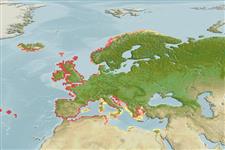Common names from other countries
Classification / Names / Names
आम नाम | उपशब्द | Catalog of Fishes (gen., sp.) | ITIS | CoL | WoRMS
Environment: milieu / climate zone / depth range / distribution range
पारिस्थितिकी
ड़िमरसल. Temperate
Northeast Atlantic, Black Sea and the Mediterranean Sea. Temperate to subtropical.
Length at first maturity / आकार / वज़न / Age
Maturity: Lm ? range ? - ? cm
Known from littoral zone to depths of 20 m. This is a coastal species found in swarms among Zostera weeds close to the shore (Ref. 85342).
Life cycle and mating behavior
परिपक्व अवधि | पुनरुत्पत्ति | मछलीऔ का अंडे देना | अंडे | Fecundity | लार्वा
Members of the order Mysida are gonochoric. Mating behavior: Male inserts the penis into the marsupium and releases sperm; eggs are then released from the oviducts into the marsupium where fertilization occurs. Life cycle: Eggs are brooded in the marsupium and later hatch into miniature adults, no postlarva.
Greve, W., F. Reiners, J. Nast and S. Hoffmann. 2004. (Ref. 2988)
IUCN Red List Status (Ref. 130435)
CITES status (Ref. 108899)
Not Evaluated
Not Evaluated
Human uses
| FishSource |
साधन
अधिक जानकारी
Age/Size
बाढ़
Length-weight
Length-length
आकृति विज्ञान
लार्वा
बहुतायत
इंटरनेट स्रोत
Estimates based on models
Preferred temperature
(Ref.
115969): 10.7 - 19.3, mean 15.5 (based on 344 cells).
Price category
Unknown.
